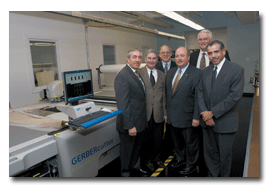Cotton Incorporated, Cary, N.C., has
brought several divisions together into a new Global Product Supply Chain division with the
objective of improving cotton’s position and profitability in the global marketplace. Mark Messura,
who has been promoted to executive vice president from his former position as vice president,
Strategic Planning, heads the new division — which includes the former Textile Research, Fashion
Marketing, Global Product Marketing and Strategic Planning divisions.
“By repositioning certain departments, we are able to be more flexible and responsive to the
rapidly changing global market,” said J. Berrye Worsham, president and CEO. “We need to better link
and prioritize the research developments with the worldwide implementation of those services.
Bringing it all under one division will help us do that.”
Worsham praised Messura’s strategic planning experience and qualifications to lead the new
division. Messura previously managed Cotton Incorporated’s fiber economics research, consumer and
market research, and corporate planning programs. He also serves as vice chairman of the
International Forum for Cotton Promotion, comprised of 17 cotton industry organizations from 13
countries and dedicated to expanding the global market for cotton by promoting local
consumption.
May/June 2006





